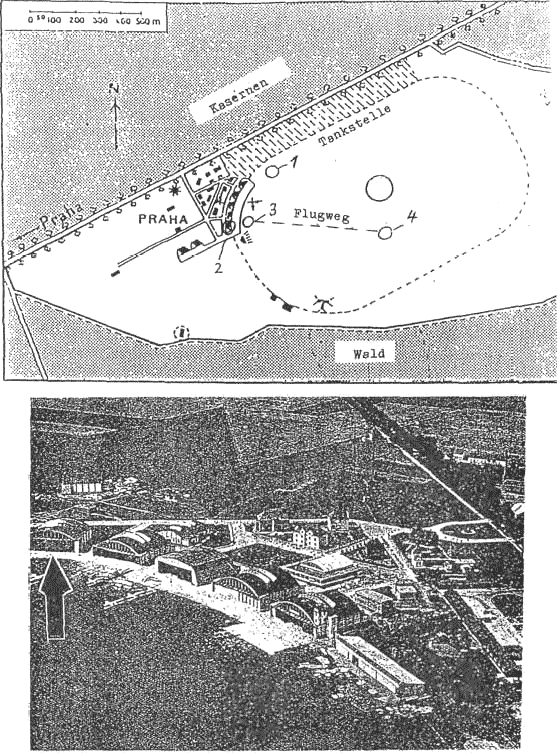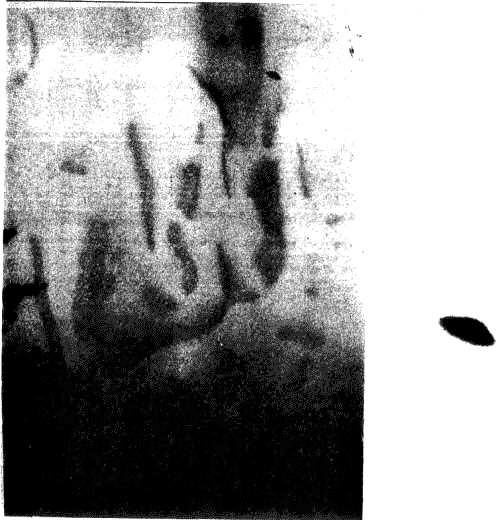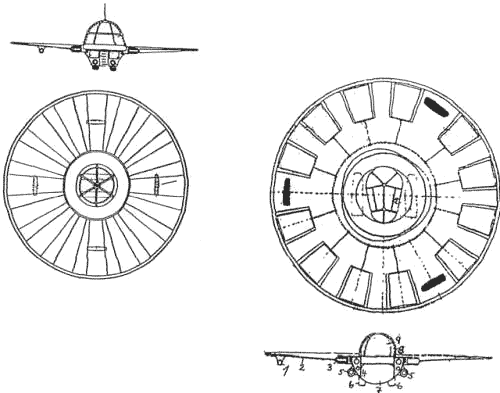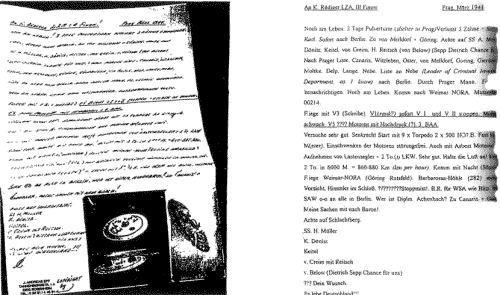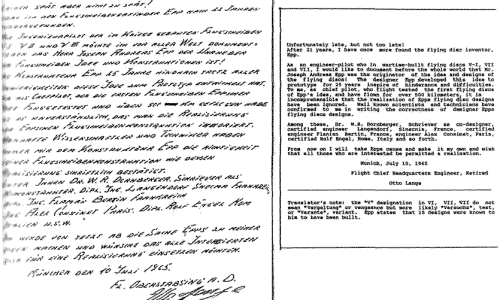|
The Schriever-Habermohl Project(s)The best known of these projects is usually referred to as the Schriever-Habermohl project although it is by no means clear that these were the individuals in charge of the project. Rudolf Schriever was an engineer and test pilot. Less is known about Otto Habermohl but certainly he was an engineer. This project was centered in Prag, at the Prag-Gbell airport (l)(2). Actual construction work began somewhere between 1941 and 1943 (3)(4).This was originally a Luftwaffe project which received technical assistance from the Skoda Works at Prag and at a Skoda division at Letov (5) and perhaps elsewhere (6). Other firms participating in the project according to Epp were the Junkers firm at Oscheben and Bemburg, the Wilhelm Gustloff firm at Weimarand the Kieler Leichtbau at Neubrandenburg (7). This project started as a project of the Luftwaffe, sponsored by second-in-command, Ernst Udet. It then fell under the control of Speer's Armament Ministry at which time it was administered by engineer Georg Klein. Finally, probably sometime in 1944, this project came under the control of the SS, specifically under the purview of General Hans Kammler (8). According to his own words, Georg Klein saw this device fly on February 14, 1945 (9). This may have been the first official flight, but it was not the first flight made by this device. According to one witness, a saucer flight occurred as early as August or September of 1943 at this facility. The eyewitness was in flight-training at the Prag-Gbell facility when he saw a short test flight of such a device. He states that the saucer was 5 to6 meters in diameter (about 15 to 18 feet in diameter) and about as tall as a man, with an outer border of 30-40 centimeters. It was "aluminum" in color and rested on four thin, long legs. The flight distance observed was about 300 meters at low level of one meter in altitude. The witness was 200 meters from the event and one of many students there at the time (10). Joseph Andreas Epp, an engineer who served as a consultant to both the Schriever-Habermohl and the Miethe-Belluzzo projects, states that fifteen prototypes were built in all (11) (12). The final device associated with Schriever-Habermohl is described by engineer Rudolf Lusar who worked in the German Patent Office, as a central cockpit surrounded by rotating adjustable wing-vanes forming a circle. The vanes were held together by a band at the outer edge of the wheel-like device. The pitch of the vanes could be adjusted so that during take off more lift was generated by increasing their angle from a more horizontal setting. In level flight the angle would be adjusted to a smaller angle.This is similar to the way helicopter rotors operate. The wing-vanes were to be set in rotation by small rockets placed around the rim like a pinwheel. Once rotational speed was sufficient,lift-off was achieved. After the craft had risen to some height the horizontal jets or rockets were ignited and the small rockets shut off (13). After this the wing-blades would be allowed to rotate freely as the saucer moved forward as in an auto-gyrocopter. In all probability, the wing-blades speed, and so their lifting value, could also be increased by directing the adjustable horizontal jets slightly upwards to engage the blades,thus spinning them faster at the digression of the pilot.
The Airport at Prag-Gbell
Site of the Schriever
and Habermohl Flying Saucer Projects
The Habermohl Saucer In Flight To the left is the closest shot of the two taken by Joseph Andreas Epp as he drove to the Prag airport in 1944. To the right is a blow up (400 times) of that same saucer. Epp remembers a date of November, 1944 but the foliage on the trees argues for a date earlier in the year. Rapid horizontal flight was possible with these jet or rocket engines. Probable candidates were the Junkers Jumo 004 jet engines such as were used on the famous German jet fighter, the Messerschmitt 262. A possible substitute would have been the somewhat less powerful BMW 003 engines. The rocket engine would have been the Walter HWK109 which powered the Messerschmitt 163 rocket interceptor (14). If all had been plentiful, the Junkers Jumo 004 probably would have been the first choice. Epp reports Jumo 211/b engines were used (15). Klaas reports the Argus pulse jet (Schmidt-duct), used on the V-l, was also considered (16).All of these types of engines were difficult to obtain at the time because they were needed for high priority fighters and bombers, the V-l and the rocket interceptor aircraft. Joseph Andreas Epp reports in his book Die Realitaet der Flugscheiben (The Reality of the Flying Discs) that an official test flight occurred in February of 1945. Epp managed to take two still pictures of the saucer in flight which appear in his book and are reproduced here. There is some confusion about the date of these pictures. In the video film "UFOs Secrets of the3rd Reich", Epp states these pictures were taken in the Fall of1944. In his book the date is given as the official date of February 14, 1945. In personal correspondence to me of December, 30, 1991, he indicated the date of the pictures as August, 1944. In that correspondence he further revealed that the official flight had been February 14, 1945 but an earlier lift-off had taken place in August of 1944. The pictures show a small disc-like object in the distance at some altitude posed above a landscape. The saucer is at too great a distance and altitude to show any mechanical detail. As Klaus-Peter Rothkugel points out,the foliage on the trees indicates the August date as being the most accurate. Very high performance flight characteristics are attributed to this design. Georg Klein says it climbed to 12,400 meters (over37,000 feet) in three minutes (17) and attaining a speed around that of the sound barrier (18). Epp says that it achieved a speed of Mach 1 (about 1200 kilometers per hour or about 750miles per hour) (19). From his discussion, it appears that Epp is describing the unofficial lift-off in August, 1944 at this point. He goes on to say that on the next night, the sound barrier was broken in manned flight but that the pilot was frightened by the vibrations encountered at that time (20). On the official test flight, Epp reports a top speed of 2200 kilometers per hour (21). Lusar reports a top speed of 2000kilometers per hour (22). Many other writers cite the same or similar top speed. There is no doubt of two facts. The first is that these are supersonic speeds which are being discussed. Second, it is a manned flight which is under discussion. But at least one writer has discounted such high performance(23). It is argued that the large frontal area of one of the possible designs in question makes Mach 2 flight impossible. The argument seems to be that given the possible power plants the atmospheric resistance caused by this frontal area would slow the craft to a point below the figures stated earlier. Some new information has come to light regarding the propulsion system which supports the original assessment. Although actual construction had not started, wind-tunnel and design studies confirmed the feasibility of building a research aircraft which was designated Project 8-346. This aircraft was not a saucer but a modern looking swept-back wing design. According this post-war Allied intelligence report, the Germans designed the 8-346 to flying the range of 2000 kilometers per hour to Mach 2. (24).Interestingly enough, it was to use two Walther HWK109 rocket engines. This is one of the engine configurations under consideration for the Schriever-Habermohl saucer project. As an aside, it should be noted that there are those who will resist at any attempt to impugn the official breaking of the sound barrier by Chuck Yeager in 1947 in the Bell X-l rocket aircraft. They had better brace themselves. This record has also been challenged from another direction. This challenge was reported in February, 2001, by the Associated Press, Berlin. It seems that a certain Hans Guido Mutke claims he pushed his Messerschmitt jet fighter, the Me-262, through the sound barrier in 1945. This occurred during an emergency dive to help another German flyer during air combat. At that time he experienced vibrations and shaking of the aircraft. According to the report,a Hamburg Professor is working on a computer simulation in order to check the validity of this claim. Returning to the topic at hand, Schriever continued to work Anthe project until April 15, 1945. About this time Prag was threatened by the Soviet Army. The Czech technicians working on this project were reported to have gone amuck, looting the facility as the Russians approached. The saucer prototype(s) at Prag-Gbell were pushed out onto the tarmac and burnt. Habermohl disappeared and presumably ended up in the hands of the Soviets. Schriever, according to his own statements, packed the saucer plans in the trunk of his BMW and with his family drove into Southern Germany. After cessation of hostilities Schriever worked his way north to his parents house in Bremerhaven-Lehe.There Schriever set up an inventor-workshop. On August 4, 1948there was a break in to the workshop in which Schriever's plans and saucer model were stolen (25). Schriever was approached by agents of "foreign powers" concerning his knowledge of German saucers. He declined their offers, preferring rather menial work driving a truck for the U.S. Army (25). Schriever is reported to have died shortly thereafter in 1953. There is a report, however, that his death was reported prematurely and that he was identified by a witness who knew him in Bavaria in 1964 or 1965 (26). The publisher of this book, Thomas Mehner, was so kind as to send me a copy of the statement by a Bavarian woman who knew Schriever and made this claim (27). This means that there is a possibility that Schriever did do post-war work on flying saucers. Interestingly enough, Schriever never claimed that his saucer ever flew at all! If this true, Schriever's saucer was still in the pre-flight stage at the time of the Russian advance and its ultimate destruction on the Prag-Gbell tarmac. This is in direct contradiction to the sources cited above and the photographic evidence. How can this seeming inconsistency be explained? J. Andeas Epp has always maintained that it was he who originated the type of design used in the Schriever-Habermohl project (28). He states in his book that the imbalance in the ring of wing- vanes which plagued the early Schriever-Habermohl prototypes was a deviation from his original design in which the wing-vanes were lengthened. He states that when they returned to his original design, the saucer was able to take off (29) (30). He referred to the saucer used in the August, 1944 unofficial lift-off, the saucer whose wing-vanes had been altered and then corrected through his intervention, as the "Habermohlischen Version", theHabermohl version (31). Could the discrepancy referred to above be accounted for if there were actually two lines of saucers built by Schriever and Habermohl? In other words, could the Schriever-Habermohl project have actually been a Schriever project and a Habermohl project,two separate designs within the team? Georg Klein seems to answer this question, stating that "three constructions" which were finished at Prag by the end of 1944. One of these, he says,was a design by Dr. Miethe (32). The best interpretation of the words of both Epp and Klein would indicate that both Schriever and Habermohl each produced their own design. Schriever made no claim that his design flew. Epp claims the Habermohl design didfly in August, 1944 and again in February 14, 1945. This was the saucer witnessed by both Klein and Epp in flight. Therefore, the history of the Schriever-Habermohl project in Prag can be summarized in a nutshell as follows: Epp's statement is that it was his design and model which formed the basis for this project. This model was given to General Erst Udet which was then forwarded to Dr. Walter Dornberger at Peenemuende. Dr. Dornberger tested and recommended the design (33) which was confirmed by Dornberger to Epp after the war (34). A facility was set up in Prag for further development and the Schriever- Habermohl team was assigned to work on it there. At first this project was under the auspices of Hermann Goering and the Luftwaffe (35). Sometime later the Speer Ministry took over the running of this project with chief engineer Georg Klein in charge(36). Finally, the project was usurped by the SS in 1944, along A Comparison of the Schriever and Habermohl Designs On the left is the Schriever design while on the right is the Habermohl design. Please note the differing dimensions of the vane blades. This difference caused instability in the Schriever design. Drawings adapted from the work of Klaus-Peter Rothkugel. with other saucer projects, and fell under the purview of Dr. Hans Kammler (37). Schriever altered the length of the wing-vanes from their original design. This alteration caused the instability. Schriever was still trying to work out this problem in his version of the saucer as the Russians overran Prag. Haberrmohl, according to Epp, went back to his original specifications, with two or three successful flights for his version. While speaking of flight success, two more pieces of important evidence exists which were supplied by Andreas Epp. One comes in the form of a statement by a German test pilot, Otto Lange, given years after the war to Andreas Epp. In that statement, signed by Lange, Epp is credited with the idea behind the invention of the flying saucer and states that none other than Dr. Walter Dornberger had a hand in its development. He also makes the astonishing claim that he, personally, test flew this flying saucer for 500 kilometers in the course of testing (38) (39). Otto Lange is a person who is known historically and independently of any connection to Epp. Lange is mentioned in U.S. intelligence documents as a member of the "Rustungsstab"(Armament Staff), for aircraft (40). This is some confusion on this issue since a German researcher, Klaus-Peter Rothkugel, has found evidence for three individuals with this name serving in the German military at this time. Mr. Rothkugel, has suggested that the statement by Lange, discussed above, was, in fact, written by Epp based on known examples of Epp's hand writing. It was signed by another hand, so perhaps Epp and Lange had a chance meeting in 1965 wherein the letter was drafted by Epp in an effort to further document his, at that time, little-acknowledged involvement in the German saucer projects. The second piece of evidence, also supplied by Epp, is a wartime Letter from Prag, dated March, 1944. It speaks to the conditions behind German lines with its opening greeting, simply "Still Alive!". It follows in a cryptic style describing historically well known political and military people who apparently knew or had something to do with the saucer project at Prag. The letter also describes some early prototype saucer models and their shortcomings. Interestingly enough figures on thrust are given Three pictures appear at the bottom of the letter. One definitely shows a saucer in flight. There is no mention of these pictures in the text of the letter. Because they are not referenced and from their placement on the face of the letter it is possible that these pictures may have been a later addition to that letter. There are some other reasons why these pictures may not have been connected to the Schriever-Habermohl project or the Miethe-Belluzzo project. We shall return to these pictures at a later time. An interesting fact elucidated by Epp is that the senior experts and advisors for both the Schriever-Habermohl project and the next project to be discussed, the Miethe-Belluzzo project, were exactly the same individuals (43). Cryptic And Enigmatic Letter Describes Flying Disc Development On the left is the original letter sent to the author by Andreas Epp. On the right is a typed version done by Kadmon. Notes in English are directed to the author. The letter starts without any formal or Informal greeting, stating only "Still alive". Flying disc research "sehr gut" with vertical take-off at speeds of 860-880 per hour (525-550 miles per hour). Flying Disc Test Pilot Otto Lange Original and author's translation of letter signed by Lange acknowledging Epp's role in flying disc history The Schriever-Habermohl Project(s) Sources and References
Section IndexIndex |
